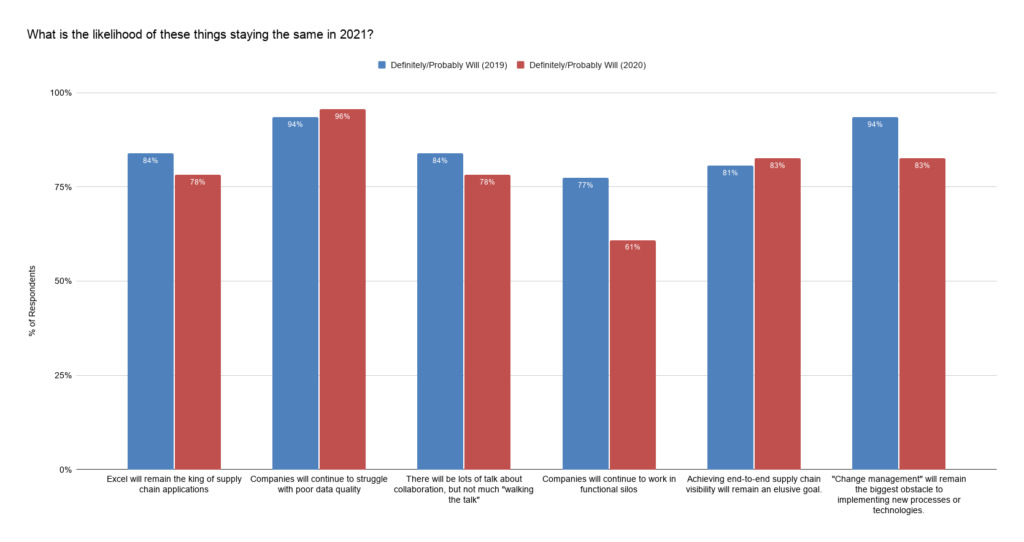In December 2019, I made some predictions for 2020. However, instead of making predictions like “Walmart Will Buy FedEx to Compete with Amazon” or “The Consolidation of Digital Freight Brokers Begins,” I made some totally predictable predictions.
That is, instead of predicting what might change in 2020, I predicted what would likely stay the same yet again. Here was my list of predictions:
- Excel will remain the king of supply chain applications.
- Companies will continue to struggle with poor data quality.
- There will be lots of talk about collaboration, but not much “walking the talk.”
- Companies will continue to work in functional silos.
- Achieving end-to-end supply chain visibility will remain an elusive goal.
- “Change management” will remain the biggest obstacle to implementing new processes or technologies.
- Industry analysts will continue to make predictions and be wrong most of the time.
At the time, we asked our Indago research community for their thoughts on these predictions. The majority of the respondents believed that all of the predictions “Definitely will” or “Probably will” stay the same in 2020 – with “Companies will continue to struggle with poor data quality” and “Change management will remain the biggest obstacle to implementing new processes or technologies” receiving the most “Definitely will” votes (52%).
Fast forward a year and we asked our Indago members — who are all supply chain and logistics executives from manufacturing, retail, and distribution companies — the same question again. Will these predictions hold true in 2021, despite all of the talk about the Covid-19 pandemic serving as a catalyst for change and innovation?
Once again, the majority of the respondents believe that all of the predictions “Definitely will” or “Probably will” stay the same in 2021. However, there were some notable year-over-year differences.

“Companies will continue to struggle with poor data quality” topped the list again, with 96% of the respondents (up from 94% last year) saying it “Definitely” or “Probably” will stay the same this year.
“Achieving end-to-end supply chain visibility will remain an elusive goal” also saw a slight increase this year, with 83% of the respondents saying it “Definitely” or “Probably” will stay the same this year (compared to 81% last year).
The remaining predictions, however, all saw decreases in this year’s survey. The biggest decline was with “Companies will continue to work in functional silos,” with 61% of this year’s respondents saying it “Definitely” or “Probably” will stay the same this year compared to 77% last year. Similarly, “Change management will remain the biggest obstacle to implementing new processes or technologies” dropped from 94% last year to 83% this year, and “Excel will remain the king of supply chain applications” dropped from 84% to 78%.
These results suggest that perhaps the pandemic is indeed driving companies to replace their spreadsheets with more robust software (i.e., accelerate their digital transformation efforts) and to break down their functional silos and collaborate more. We’ll see.
What do you think? Do you agree with our Indago members? Will these predictions hold true in 2021? Post a comment and share your perspective!
Join Indago
Also, If you’re a supply chain or logistics practitioner from a manufacturing, retail, or distribution company, I encourage you to learn more about Indago and join our research community. It is confidential, there is no cost to join and the time commitment is minimal (2-5 minutes per week) — plus your participation will help support charitable causes like JDRF, American Logistics Aid Network, American Cancer Society, Feeding America, and Make-A-Wish.
You can also follow us on LinkedIn to stay informed of our latest research results and news.










